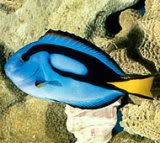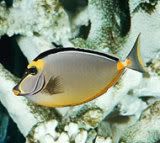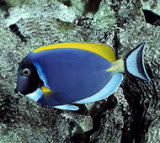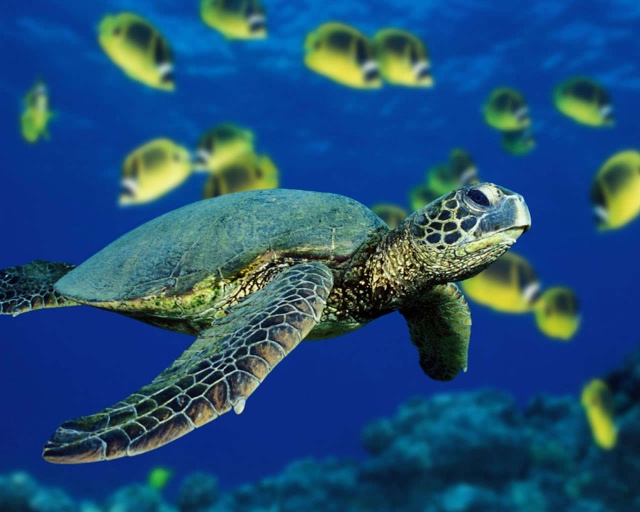Search
Latest topics
FACEBOOK LIKE BUTTON
TANGS
Page 1 of 1
 TANGS
TANGS
CHECK OUT THIS THREAD CONTAINING SPECIES PROFILES AND IMPORTANT INFORMATION TO KNOW..
PLEASE DO NOT POST QUESTIONS OR COMMENTS IN THIS THREAD..PLEASE USE THE MAIN SALTWATER FISH THREAD..
THANKS ADMIN.
PLEASE DO NOT POST QUESTIONS OR COMMENTS IN THIS THREAD..PLEASE USE THE MAIN SALTWATER FISH THREAD..
THANKS ADMIN.
Last edited by Shannon *Admin* on Sat Jan 03, 2009 2:06 pm; edited 2 times in total
 ACHILLES TANG
ACHILLES TANG

Scientific Name: Acanthurus achilles
Family: Acanthuridae
Size: 8 to 10 inches
Temperature: 74 to 78 degrees Fahrenheit
Origin: Western and Central Pacific Ocean
The Achilles tang is one of the most spectacular fish available for the aquarium, but it is also one of the most difficult to keep. This fish swims continuously, and usually at a very high speed, so it requires a large tank with plenty of open space. It also requires fairly turbulent water movement. When kept in conditions of less-than-ideal water movement and/or in too small a tank, this fish will be very nervous, usually not feed, and wither and die fairly quickly. It is usually fairly expensive, so this may help prevent hobbyists with less-than-ideal conditions from keeping this fish.
Generally reef-safe, an Achilles tang does well in a reef tank that has high water movement. It should be the only tang in a tank because it is very intolerant of any fish that looks in any way similar to it. When it comes to feeding, it requires an herbivore diet, but it should be presented with a wide variety of foods to choose from. Nori, blanched romaine lettuce or zucchini should always be present in a clip on the side of the tank. An Achilles tang looks for food all of the time, so it must be able to feed constantly.
 HIPPO TANG * Paracanthurus hepatus*
HIPPO TANG * Paracanthurus hepatus*

Scientific Name: Paracanthurus hepatus
Family: Acanthuridae
Size: 12 inches in the wild, aquarium specimens up to 8 inches
Temperature: 74 to 78 degrees Fahrenheit
Origin: Indian and Pacific Oceans
The hippo tang has become extremely popular since Disney’s Finding Nemo came out. In the movie, Marlin, Nemo’s father, befriends a hippo tang named Dory. A hippo tang is a spectacularly beautiful fish, almost always available at local fish stores, and once it gets over acclimation, it is usually fairly hardy. The main problem with this fish is that it tends to get ich, with practically every hippo tang going through one or more bouts with ich before becoming established in a tank.
The hippo tang is basically a reef-safe fish, but because it is so susceptible to ich and other parasites, it can be problematic in reef tanks where copper cannot be used as treatment. With a hippo tang, it is imperative that it is first placed in a quarantine tank. Even then, there can be problems when it is moved into the main tank.
This fish is basically an omnivore, and it needs both meaty and vegetable foods. Leaving some nori or other leafy vegetable hanging on a clip in the tank is a good idea, but it should also be fed general preparations for all kinds of fish. A small hippo will get along fairly well, but when it gets larger it can be a less-than-perfect citizen, although it is not as bad as most other tangs.
Last edited by Admin on Wed Nov 26, 2008 2:33 pm; edited 1 time in total
 NASO TANG *Naso literatus*
NASO TANG *Naso literatus*

Scientific Name: Naso literatus
Family: Acanthuridae
Size: 16 inches in the wild, aquarium specimens up to 10 inches
Temperature: 74 to 78 degrees Fahrenheit
Origin: Pacific Ocean Japan to Hawaii (the Indian Ocean fish are now recognized as a separate species, N. elegans
The naso tang goes by a number of different common names, often called the “lipstick” tang for the fact that the lips of the fish look like they were painted in place. However, it is universally called “Naso”, which is its genus.
The naso tang usually does best if it is the only type of tang in a tank. However, really big tanks over 200 gallons may be able to support other tangs in addition to the naso.
This fish is constantly moving through the aquarium at great speed and making sharp turns. It requires excellent water quality, with plenty of water movement and lots of open space. The naso tang is basically reef-safe when it comes to invertebrates, and it will constantly graze on macroalgae throughout the tank.
The naso tang should be fed various types of algae and other vegetable foods. It is a good idea to have a clip on the side of the tank containing brown algae; it will also graze on nori or blanched romaine lettuce. It requires the brown algae in its diet, and there are now prepared foods available from your local fish store that are high in this type of algae.
 POWDER BLUE TANG *Acanthurus leucosternon*
POWDER BLUE TANG *Acanthurus leucosternon*

Scientific Name: Acanthurus leucosternon
Family: Acanthuridae
Size: 16 inches in the wild, aquarium specimens up to 10 inches
Temperature: 74 to 78 degrees Fahrenheit
Origin: Indian Ocean to Indonesia in the Pacific[b]
The powder blue tang (often called by its scientific species name leucosternon) is one of the most beautiful and coveted fish for marine aquariums. A mature powder blue tang has many different shades of blue, from dark navy to light powder blue, with bright yellow on the dorsal fin and dramatic black markings on the face. However, it is also one of the more difficult fish to keep on a long-term basis. Initial problems are primarily with marine ich, to which most surgeons and tangs are very susceptible. The powder blue tang is extremely susceptible to this parasite, and almost every powder blue in a tank will have to go through at least one bout with ich.
Once a healthy powder blue is established in a tank, it will be a large, fairly aggressive fish. This fish must be the only tang (or similarly shaped fish) in the tank unless it is a very large aquarium. It can become very territorial and nasty to other large fish, and it requires a large amount of swimming room. The minimum size tank for a powder blue is 90 gallons, and the bigger the tank the better.
This fish feeds constantly, and it is best to always have nori seaweed, blanched zucchini or romaine lettuce in a clip on the side of the aquarium. In addition, it needs to be fed regularly with specialized herbivore diets containing Spirulina algae. A powder blue tang is generally reef-safe, as long as it is well fed.
 YELLOW TANG *Zebrasoma flavescens*
YELLOW TANG *Zebrasoma flavescens*

Scientific Name: Zebrasoma flavescens
Family: Acanthuridae
Size: 6 to 8 inches
Temperature: 74 to 78 degrees Fahrenheit
Origin: Pacific Ocean, especially around Hawaii
The yellow tang is a standard fish for marine aquariums. It is hardy, fairly resistant to disease, and in general a good citizen for either a fish-only or reef aquarium. The yellow tang is probably the fish caught in the most quantities in Hawaii. However, there are efforts going on now to both spawn and raise the yellow tang commercially, and to also take larvae from the plankton rafts and raise these. It is hoped that a good supply of aquacultured fish will become available soon. Meanwhile, the numbers of fish taken from Hawaii are monitored to prevent overfishing.
Keeping a yellow tang requires a very large tank (125 gallons or more), and it is best to introduce all of the tangs at the same time. This way, they will usually do fine together. An individual, especially if established for a long time in an aquarium, will be very territorial and aggressive toward any fish introduced that is even close to its shape and/or color.
A yellow tang will eat just about everything presented to it, but it requires a high degree of vegetable matter in its diet. It should be fed prepared herbivore diets, and there should always be some nori, romaine lettuce or zucchini on a clip on the side of the tank on which it can graze.
Page 1 of 1
Permissions in this forum:
You cannot reply to topics in this forum
 Home
Home








» Coral In Stock (April, 11 2014)
» Official Canada Corals Introduction
» Looking for Bubble Tip Anemone
» A big Welcome to our new Sponsor CANADA CORALS!!
» Good News..
» BIG ALS MARCH 29-APRIL 4TH
» L.E.D Lighting
» ELEGANCE